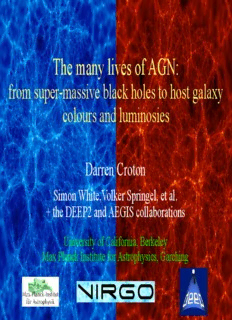
The many lives of AGN: - Berkeley Cosmology Group PDF
Preview The many lives of AGN: - Berkeley Cosmology Group
The many lives of AGN: from super-massive black holes to host galaxy colours and luminosies Darren Croton Simon White,Volker Springel, et al. + the DEEP2 and AEGIS collaborations University of California, Berkeley Max Planck Institute for Astrophysics, Garching Motivation: the colour bi-modality (Baldry et al. 2005) (Kauffmann et al. 2003) Galaxies appear to live two lives ... why? Motivation: how do you build the red sequence? SDSS 1030+0524 z=6.28 z<0.2 Hubble Space Telescope High & low redshift quasars and merger induced quasar winds can make galaxies red ... e.g. Hopkins et al. 2005 Motivation: how do you build the red sequence? ... but quasars are not seen today at the centres of galaxy clusters Radio jets, bubbles are seen and can suppress cooling gas ... (Binney et al. 1995, Best et al. 2005) Aims 2dFGRS How does AGN heating influence the final properties of the galaxy population? I will present a model that illustrates how one can self-consistently explain: the existence of the red sequence, the turn-over of the luminosity function, the build up of stellar mass at the high mass end. We use a dark matter simulation of cosmological scale, coupled with a model of galaxy formation with AGN, to investigate this problem. (DC et al. 2006) The Millennium Run Simulation The Millennium Run N-body LCDM simulation (Springel et al. 2005): 1010 dark matter particles 500 Mpc/h box side length mass resolution of 8.6 x 108 Msun softening of 5 kpc/h ~7 million galaxies identified at z=0 (M <-17) B The Millennium Run's resolution is such that all galaxies more massive than the LMC can be resolved in a volume comparable to 2dFGRS and SDSS. Building the Galaxy Population The semi-analytic model of galaxy formation (White & Frenk 1992): •gas infall and cooling •star formation •supernova feedback •galaxy mergers and starbursts •metal enrichment •two mode AGN model (DC et al. 2006) Populating Galaxies with Black Holes The AGN “quasar” mode: In the quasar mode, super-massive black holes grow through merging events where black holes coalesce and cold disk gas is driven onto the central black hole. This is the primary mode of black hole growth (Kauffmann & Haeanelt 2000)
Description: